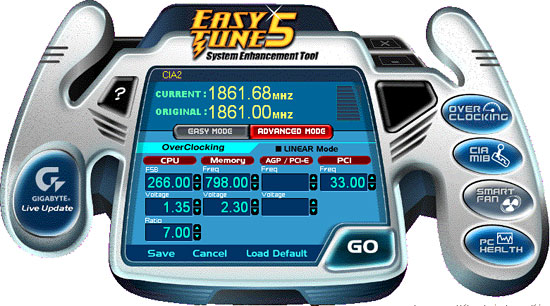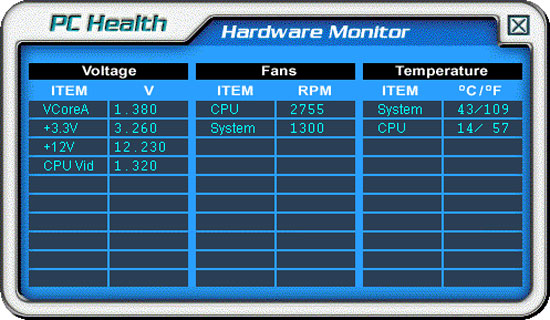Intel P965: The Double Mint Twins Gone Wild
by Gary Key on November 9, 2006 8:00 PM EST- Posted in
- Motherboards
Gigabyte GA-965P-S3: Feature Set
The Gigabyte GA-965P-S3 is slotted in between the Biostar P965PT and the Gigabyte GA-965P-DS3. Like the Biostar P965PT it uses the Intel ICH8 but also adds two additional SATA ports and RAID capabilities via the JMicron JMB363 chipset that also serves as the IDE controller. The S3 does not come with Firewire capability which is a mistake in our opinion.
The BIOS is feature rich like the DS3 and is geared towards the enthusiast with a significant amount of voltage/memory timing options available, provided you remember to press Ctrl-F1 while in the BIOS setup screen. Why Gigabyte continues to force the user to remember this keystroke sequence for additional BIOS options is beyond us.


Gigabyte also includes a full suite of utilities for the board: EasyTune5, M.I.T. (Motherboard Intelligent Tweaker), Download Center, Xpress Install, @BIOS, Smart LAN, Smart Fan, and Virtual Dual BIOS. We found the @BIOS utility to be very handy for downloading and then updating the BIOS while in Windows. For those who are squeamish about updating their BIOS within Windows, Gigabyte has the Q-Flash utility built into the BIOS that allows updating from a floppy drive.
EasyTune5 is probably one of the most useful utilities in the Gigabyte arsenal and allows for control of the FSB settings and certain voltages within Windows, although a reboot is required to change most voltage settings. We found the utility worked well for squeezing out those last few FSB increases but we still found ourselves tweaking the BIOS the majority of the time. The PC Health monitor provided basic readings of the system but for some odd reason our CPU temperature liked to blip under 20C when capturing our screenshots. Our actual idle temps at stock settings were 25C on this board at time of testing. The Smart Fan utility allows control over the two fan headers located on the board.
Like our other boards in these roundups, Gigabyte includes a dynamic overclocking capability dependent on system load or preset attributes. This capability can be located within the BIOS under the C.I.A.2 setting. The settings range from Cruise (5% increase) to Full Thrust (17% increase). We decided to see how well this motherboard performed at Full Thrust. The blank screen after rebooting led us to believe we had selected the Zero Thrust option. After a quick CMOS clear event we backed down to the Turbo (15% increase) setting and were able to complete our benchmark testing. C.I.A.2 determined our Turbo settings would end at a final 7x308FSB providing a CPU speed of 2156MHz and our memory running at DDR2-924 with 5-5-5-15 settings. Just as predicted by C.I.A.2 an increase of just over 15% in the FSB speed was realized matching our settings on the DS3.
| Gigabyte GA-965P-S3 | |
| Market Segment: | Budget Performance - $115.99 |
| CPU Interface: | Socket T (Socket 775) |
| CPU Support: | LGA775-based Pentium 4, Celeron D, Pentium D, Pentium EE, Core 2 Duo, Core 2 Extreme |
| Chipset: | Intel P965 + ICH8 |
| Bus Speeds: | 100 to 600 in 1MHz Increments |
| Memory Ratios: | Auto, 2, 2.5, 3, 2.66, 3.33, 4 |
| PCIe Speeds: | Auto, 90MHz~150MHz in 1MHz Increments |
| PCI: | Fixed at 33.33MHz |
| Core Voltage: | Normal, 1.0250V to 1.6000V in 0.00625V increments, 1.80V, 2.0V |
| CPU Clock Multiplier: | Auto, 6x-11x in 1X increments if CPU is unlocked, downwards unlocked, Core 2 Duo |
| DRAM Voltage: | Normal, +.1V ~ +.7V in +.1V increments |
| DRAM Timing Control: | Normal, 9 DRAM Timing Options, Memory Performance Enhance Mode |
| FSB Termination Voltage: | Normal, +.1V ~ +.3V in +.1V increments |
| MCH Voltage: | Normal, +.1V ~ +.3V in +.1V increments |
| Memory Slots: | Four 240-pin DDR2 DIMM Slots Dual-Channel Configuration Regular Unbuffered Memory to 8GB Total |
| Expansion Slots: | 1 - PCIe X16 3 - PCIe X1 3 - PCI Slot 2.3 |
| Onboard SATA/RAID: | 4 SATA 3Gbps Ports - Intel ICH8 2 SATA 3Gbps Ports - (RAID 0,1,JBOD) - JMicron JMB363 |
| Onboard IDE: | 1 ATA133/100/66 Port (2 drives) - JMicron JMB363 |
| Onboard USB 2.0/IEEE-1394: | 10 USB 2.0 Ports - 4 I/O Panel - 6 via Headers No firewire support |
| Onboard LAN: | Gigabit Ethernet Controller - PCI Express Interface Marvel 88E8056 |
| Onboard Audio: | Realtek ALC-883 8-channel High Definition Audio CODEC |
| Power Connectors: | ATX 24-pin, 4-pin EATX 12V |
| Fan Connectors: | 2 - CPU, Chassis |
| I/O Panel: | 1 x PS/2 Keyboard 1 x PS/2 Mouse 1 x Parallel Port 1 x S/PDIF Optical 1 x S/PDIF Coaxial 1 x Serial Port 1 x Audio Panel 1 x RJ45 4 x USB 2.0/1.1 |
| BIOS Revision: | Award F6 |
The Gigabyte GA-965P-S3 is slotted in between the Biostar P965PT and the Gigabyte GA-965P-DS3. Like the Biostar P965PT it uses the Intel ICH8 but also adds two additional SATA ports and RAID capabilities via the JMicron JMB363 chipset that also serves as the IDE controller. The S3 does not come with Firewire capability which is a mistake in our opinion.
The BIOS is feature rich like the DS3 and is geared towards the enthusiast with a significant amount of voltage/memory timing options available, provided you remember to press Ctrl-F1 while in the BIOS setup screen. Why Gigabyte continues to force the user to remember this keystroke sequence for additional BIOS options is beyond us.


Gigabyte also includes a full suite of utilities for the board: EasyTune5, M.I.T. (Motherboard Intelligent Tweaker), Download Center, Xpress Install, @BIOS, Smart LAN, Smart Fan, and Virtual Dual BIOS. We found the @BIOS utility to be very handy for downloading and then updating the BIOS while in Windows. For those who are squeamish about updating their BIOS within Windows, Gigabyte has the Q-Flash utility built into the BIOS that allows updating from a floppy drive.
EasyTune5 is probably one of the most useful utilities in the Gigabyte arsenal and allows for control of the FSB settings and certain voltages within Windows, although a reboot is required to change most voltage settings. We found the utility worked well for squeezing out those last few FSB increases but we still found ourselves tweaking the BIOS the majority of the time. The PC Health monitor provided basic readings of the system but for some odd reason our CPU temperature liked to blip under 20C when capturing our screenshots. Our actual idle temps at stock settings were 25C on this board at time of testing. The Smart Fan utility allows control over the two fan headers located on the board.
Like our other boards in these roundups, Gigabyte includes a dynamic overclocking capability dependent on system load or preset attributes. This capability can be located within the BIOS under the C.I.A.2 setting. The settings range from Cruise (5% increase) to Full Thrust (17% increase). We decided to see how well this motherboard performed at Full Thrust. The blank screen after rebooting led us to believe we had selected the Zero Thrust option. After a quick CMOS clear event we backed down to the Turbo (15% increase) setting and were able to complete our benchmark testing. C.I.A.2 determined our Turbo settings would end at a final 7x308FSB providing a CPU speed of 2156MHz and our memory running at DDR2-924 with 5-5-5-15 settings. Just as predicted by C.I.A.2 an increase of just over 15% in the FSB speed was realized matching our settings on the DS3.










23 Comments
View All Comments
Zak - Tuesday, November 14, 2006 - link
Yeah, WTF with the software design? Did they hire someone fired from FisherPrice or what? It's ugly and dysfunctional, even Asus AI Booster isn't THIS ugly.<Z>
mindless1 - Monday, November 13, 2006 - link
Regarding the article comment about the floppy connector,"We would just as well have this connector disappear at this time."
you might want to clarify who "we" is, since there are plenty of people who want a floppy connector even if they don't have a constant use for a floppy drive.
Remember that one person's use of a system does not equal entire world. Many legacy apps and even some emergency bios recovery routines require a floppy drive. If this were a reduced form factor board, it stands to reason that more features requiring connectors need to be left out, but to give up functionality on a whim is hardly useful, it's not as though you would have to grand replacement feature on that bottom edge, cubic inch of space otherwise.
Larso - Friday, November 10, 2006 - link
Oh my, do those motherboard monitoring/tuning applications look ugly... Ugly as in grotesque swollen blobs rather than functional design.A shame, I really liked the biostar board until the accompanying software utility appeared before for my eyes, aww... The gigabyte software is not pretty either... Can you switch the GUI to something less graphical and more standard windows widgets -like?
Do all software accompanying motherboards look like this??
Avalon - Saturday, November 11, 2006 - link
You mean you actually use software to overclock? Do it the manly way and use the BIOS.Larso - Saturday, November 11, 2006 - link
Its not about overclocking, the problem is if the motherboard software has some specific monitoring/adjusting features not available in freeware monitoring applications. Then you would have to use that monstrous software if you want the feature.Another problem is quality impression of the product as a whole. That software's user interface simply turns me off. Why don't they make the interface look like PRO tools, instead of plastic hell!
bullfrawg - Friday, November 10, 2006 - link
I think it's great that, as mentioned in the first article, you are checking out the manufacturer's tech support by pretending to be regular joes rather than review sites. So I want to express interest in seeing more detail about how tech support treats you. ASUS seems to have gotten a bad reputation lately for tech support -- is this justified in your experience? I see that you say Gigabyte has been good so far. Thanks!Staples - Friday, November 10, 2006 - link
The 965 performs very well no matter what board it is on. I will be waiting till you get a 650i Ultra board to review. I am holding out on a Core Duo and my next purchase will be between these two chipsets.Kensei - Friday, November 10, 2006 - link
Nice old school reference back to the double-mint twins. You definitely dated yourself with that one Gary.Kensei
Hikari - Friday, November 10, 2006 - link
Not really, I saw a double mint advertisement on TV with twins the other day...Kensei - Friday, November 10, 2006 - link
Really! I didn't know they had done a remake of that commercial.Ken